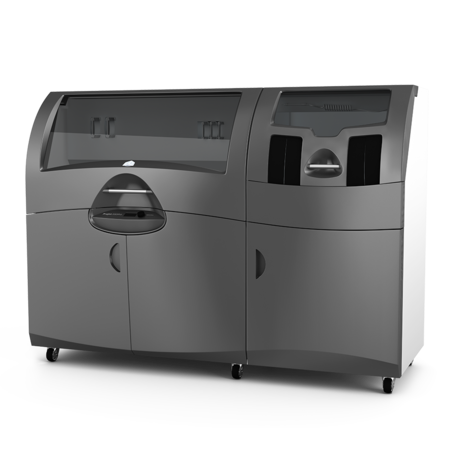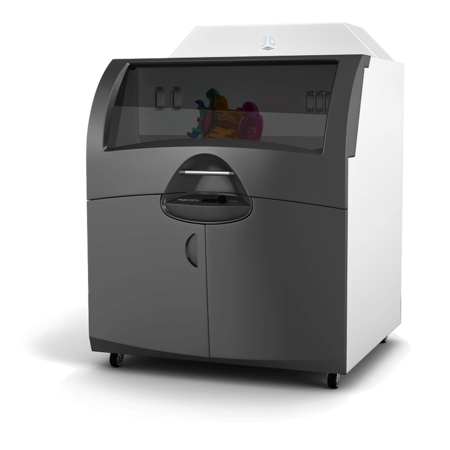"To maintain our industry leadership, we constantly need to innovate, both in our products and our product development. 3D printing is an essential tool for this continuous innovation, helping us move faster and create more alternatives at every turn." – Kris Sullenberger, Humanetics Project Engineer
The iconic crash-test dummy is anything but dumb. It’s a high-tech testing device with innumerable physical and electronic configurations to satisfy the unique needs of each customer, whether automaker, airline, space agency or the military.
The demand for sophisticated new dummy permutations is relentless. During the second Iraq war, for example, the US Department of Defense urgently needed a sophisticated head model to test a new generation of goggles and face shields. The model needed to incorporate a dozen segments representing facial bones, each having its own impact data collection sensors.
The job of producing this innovative head model went to a leader in the design, development, and manufacturing of crash-test dummies – properly called anthropomorphic test devices (ATDs) – Humanetics Innovative Solutions of Huron, Ohio.
For over 40 years, Humanetics and its progenitor companies have been leaders in ATD innovation. In the 1950s, they pioneered the industry with the development of research dummies for testing air and spacecraft ejection seats. The technology evolved in the early 1960s into automotive crash test dummies. Since then, technological advances have contributed to constant improvements in the capabilities, quality, and accuracy of crash test dummies.
Humanetics now produces a wide variety of ATDs, ranging in size from newborn infants to large adult human surrogates. The Humanetics iCrash Technology™ portfolio takes crash testing to the next level by offering devices with fully integrated data acquisition systems.
Challenge
URGENT JOB REQUIRES RAPID DEVELOPMENT
For the DOD assignment, traditional prototyping processes weren’t going to cut it. “With the aluminum molds necessary for vinyl and rubber prototypes, it would have taken three months of machine time to make the first prototype,” said Humanetics Project Engineer Kris Sullenberger. “And revisions would have been a nightmare.”
Humanetics investigated 3D printing as an alternative. With the right 3D printer, Sullenberger’s team would have been able to 3D print a mold box and pattern overnight and quickly create the silicone mold and urethane part the next morning. Humanetics chose the ProJet CJP full-color 3D printer from 3D Systems, whose composite material was a quick affordable medium for making mold boxes and patterns. 3D Systems makes the fastest 3D printers with the lowest operating costs.
“The Color Jet was the only way we could do the job,” Sullenberger said. “Time was of the essence, and the ProJet’s speed, accuracy, and resolution were best suited to the government’s needs.”
Strategy
Using 3D printing for efficient mold making
Sullenberger’s team used the ProJet to print patterns and mold boxes quickly created silicon molds and then heat-poured the urethane parts. “From start to finish, the whole product – design, building, testing, and shipping – took six months,” says Sullenberger. “Whenever we needed a revision, we simply reprinted and repoured.”
Today, Humanetics is using the ProJet to produce about 200 parts a year, often multiple parts per build. At the peak, Sullenberger’s team runs the 3D printer around the clock for three weeks on end. The company often prints multiple parts in a single build – sometimes all the same, sometimes different. This capability, unavailable in other 3D printers, increases the ProJet’s throughput and speed advantage.
Urgent job requires rapid development
Big savings in time and cost
“The 3D printer lets us make new parts for the client in a day and a half instead of the week or more it takes when we need to machine new steel or aluminum molds,” says Sullenberger. “It’s also probably 10-to-1 cost saving in materials and machine work, meaning we save hundreds of dollars on each build.”
Although most of Humanetics’ use of the ProJet is for mold and pattern production, the company also prints samples for marketers and the sales force, often explaining concepts better than words or CAD images.
“We’ll send complete scaled-down dummies to clients, including senior executives and other non-technical professionals, or we’ll send detailed models that help explain new designs,” Sullenberger says. A new design might feature a different skin texture or re-engineered sensor pockets. “Although people often don’t know what they’re looking at in a picture, it drives the information home when you print a part, split it in half, and let the person pick up the pieces, examine the internals, and put them together themselves.”
Whether for urgent prototypes or concept models that enlighten people about the role of crash-test dummies, The ProJet has introduced a new level of performance into Humanetics’ development of intelligent dummies.
“To maintain our industry leadership, we constantly need to innovate, both in our products and our product development,” says Sullenberger. “3D printing is an essential tool for this continuous innovation, helping us move faster and create more alternatives at every turn.”

